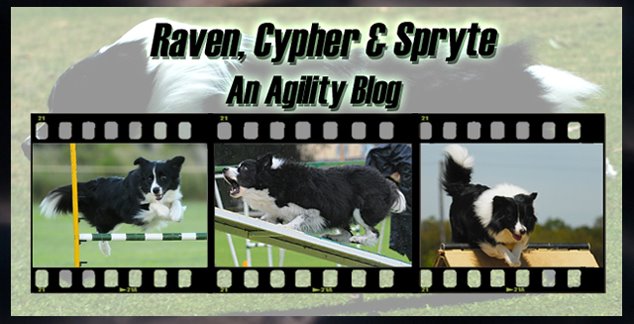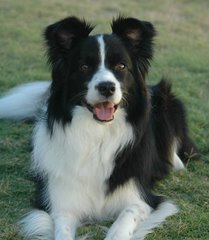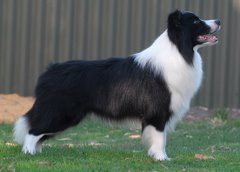Today Stacy indicated that she wanted us to work on various handling skills such as our shoulder movements, front crosses and rear crosses. First up though, she talked about an exercise that someone had enquired about the previous day to do with teaching dogs to flex from the middle of their spine leading to greater and more efficient turning capability over jumps and on the flat. We organised a witches hat or cone that was around knee height and we tried a couple of dogs on the exercise however Stacy needed a dog that wouldn’t care about where mum was and was a high toy drive, in particular willing to tug with her. I was asked to bring Cypher out (he apparently has a reputation for his somewhat insane addiction to playing tug, he’s not even 2 yet!) and although at the start he was watching me closely as soon as Stacy brought the tug out the game was on, she had him in the palm of her hand. Stacy would hold him by his collar (as an extra note here she spoke about making sure our dogs were completely unconcerned about being held by the collar, that we should be able to reach out and hold the dog by the collar without the dog feeling like it was being corrected or feeling uncomfortable). So she held him by his collar in her left hand, had the tug toy in her right hand (this was a half meter length ropey tug toy – I think this exercise would be better with a longer tuggy rather than a short one). She held Cy so that he was facing just to the left of the cone, then she brought her right hand and the tuggy round the other side of the cone (she herself was obviously positioned fairly close to the cone). When Cy could see the end of the toy on the left side of the cone and was raring to get at she let him go telling him to “Get it” in an urgent excited voice. As soon as he leapt for it she dragged it quickly round, nice and close to the cone, Cy chased it turning really tightly round the cone and he grabbed it and played when they were clear of the cone heading off at a 90 degree angle to the cone.
Another aspect that Stacy really wanted us to become better observers of is identifying when a dog was bending or flexing and turning from the middle of his spine or was just trying to pull its body round the turn using its front. From watching when I did it with Cypher a few times myself the others were able to see the difference between the two. An obvious clue is how tight the turn was, every time he flexed from the middle of his spine the turn was tight, if he didn’t the turn was loose on the cone.
The next skill Stacy addressed was the See Saw performance (or teeter as it called in the
She then asked us to give our verbal cue to the dog that we used for the seesaw end behaviour, and if we needed to we were to quick release them with whatever our release word was. This is where Cy and I exposed our big gaps in our seesaw training. (I knew we would, I haven’t been happy with his seesaw training much at all, it relies very heavily on me saying down at just the right moment and it is something that is almost impossible to be consistently on the ball with due to the massive variation we have in our seesaws in this state when it comes to how fast they drop, I’ve been trying to nut out what to do with his seesaw for ages!). We ran at it again and I said “Down” just as he got to the end, he downed immediately however one side of his rear end was not lined up with the plank and he kind of half fell off it sideways as the plank hit the ground, then corrected himself and lay there on the end of the plank waiting for his release of “ok”. It looked awkward, ugly and dangerous, all the things that Stacy observed out loud and I agreed with.
The issue with him is not about flyoffs, he doesn’t really like doing fly offs at all, the issue is that I’m not sure about what exactly I want him to do on the seesaw. I’ve never had to actually think about the process or behaviour before. With Raven I just yell “Wait” she applies the brakes and then self releases as soon as the board hits the ground. Sometimes she slides it into the ground other times she rides it and as soon as it hits she’s gone. She has an absolutely fearless approach to the obstacle and it’s always done us ok in trials so I’ve never thought to refine it or demand anything more formal. I think she has picked up the idea somehow that she has to wait till it hits the ground before she leaves but I’m not sure how. We’ve had a few calls this year for seesaws but again they are rare enough that I’ve never been motivated enough to perfect her seesaw behaviour.
I know I want him to run straight up it, get near the end (not right on the edge or anything like that – a good 30cm from the end) lie down and then release on my “ok”. So Stacy recommended that I take him back to the lower sized seesaw (in training each week) and work on getting that down in a better place and trying to fade that verbal cue out by getting so many repetitions on the low seesaw that he just starts to recognise for himself the behaviour he is running to do. I know it is going to be a work in progress for sometime to come and it is clear that the more different seesaws I get to train him on the better.
She recommended that for quite a few others, the more older dogs though who have been competing in Masters she suggested a bit of gaffer tape on the end of the seesaw with a bit squeeze cheese on it to encourage them to run to the end of the plank and ride it. From an early puppy stage though Stacy uses a very basic shaping with the clicker on the end of an extremely low seesaw (2 to 3 inches off the ground at the most) and she’ll straddle the board at the end facing the pivot point. Then she just shapes and clicks the puppies for getting all four paws on the board (starting off with a click treat for one paw, then two and so on) until pup is virtually throwing their bodies onto the board to get the treat. Stacy went into more detail about what are her next steps but I’m afraid I didn’t take those notes down! I’ll have to see if someone else remembers what she said. Next Stacy set us up the Jumping sequence for the day. She didn’t have any numbers up on it to begin with and simply showed us the first exercise. See the image below;
Stacy then asked us all to run it just being aware of what our shoulders were doing and without ANY verbals apart from whatever word we use for the jumps (Hup, Over etc), but no names or comes. Just about every single dog managed this exercise without any trouble, a few handlers got caught up running into the uprights of the box in the middle but other than that I think maybe one dog out of the whole group actually went into a tunnel. Stacy was impressed with how we managed this exercise particularly after several of us had all voiced our doubts about how we would get around this circle!
We then repeated the exercise in the other direction without too much difficulty. Some of us tried to make sure we stayed off the inner box, however we were still aware of what our shoulders were doing and by being conscious of where they were turning we were still able to keep a hold of our dog. All this without a single yell of a dog’s name or of “Come” or “Here”. I said nothing with Cypher, I just ran since I don’t tend to say anything for jumps. It was a really good shoulder awareness raising exercise!
The next exercise was more of a challenge, especially since the dogs had been patterned at least 6 times by now on the previous exercise.
This one was tough, we were still not allowed to say anything other than the jumps and now we could say the word “tunnel” or whatever word we used for the tunnel. We were not allowed to say the word “out” ARGH!!!! I got round to #5 at least three times and then Cy would cut me off each time to do #14 instead of the tunnel. This was the ultimate exercise in teaching shoulder/body cue importance. The only way I succeeded in the end was when Stacy told me that I needed to turn my shoulders more inwards on #1 to #4 so that when I straightened up and virtually pushed my right shoulder out towards the tunnel as he committed to #5 then he could see a much different picture about our direction. Several of us also struggled to not use our “off arm” to indicate the tunnel, when your shoulder is pushing out there it was incredibly hard to keep the arm from following it out there! This exercise was very valuable and one that I will need to keep working on. We didn’t even get a chance to run it the other way I don’t think, because so many of us found this one such a challenge enough already. All that thinking hard, being so self conscious about what your shoulders were doing whilst still maintaining connection with your dog was a challenge to say the least!
After lunch we then looked at tightening up our front crosses with the following sequence.

Stacy broke this one down for us after we had all had a turn on this (some of us did it well, others not so well). I felt like I was leaving Cy behind on the turns from the box jump to the outside jump, but then I was all too aware that these front crosses were definitely not our strong point. 
This was a great course to run and one that felt as smooth as silk when I ran it with Raven on another day. Cypher and I managed to get around it but he felt slow and was turning like a Mack truck again. He was still switched on to me though so I had a few goes at the course. He managed to read the rear crosses well at #5 to #6 and #9 to #10 and #15 to #16. I felt the line he took over these jumps though could have been much more improved. The dog should not be jumping over #6 at an angle that points him directly at the end of the tunnel. He should be more centred over the bar and should also be on his left lead leg rather than his right, so that he can have an efficient line to #7. A few dogs had issues with handlers not turning their shoulders just at the right moment to get the dog to cross. Too late and the dogs went in the tunnel too early and you pulled the dog off the jump, we even had a few dogs run between the jump and the tunnel. Stacy got up and showed them what line they themselves should be running and she occasionally blocked a tunnel for dogs that had patterned themselves incorrectly to take the tunnel. They took the jump once correctly and then they were fine. Again this is an exercise you can (and should!) do in reverse.






2 comments:
Thanks for the comments guys - you're the first ones ever!
S
Wow, Simone - impressive notes - thanks! I attended Stacey's workshop for three days as an auditor at Jugiong, Stacey is AMAZING, a wealth of knowledge, she can really read the different dogs and pick just what they need to hone their performance. I have used a couple of Stacey's tips to help me and Finn out in the competition ring - they have worked a treat, and I still have heaps of Stacey's tips to try. My notes remain a scribbled heap on the notepad - your organisation skills put me to shame!
Post a Comment